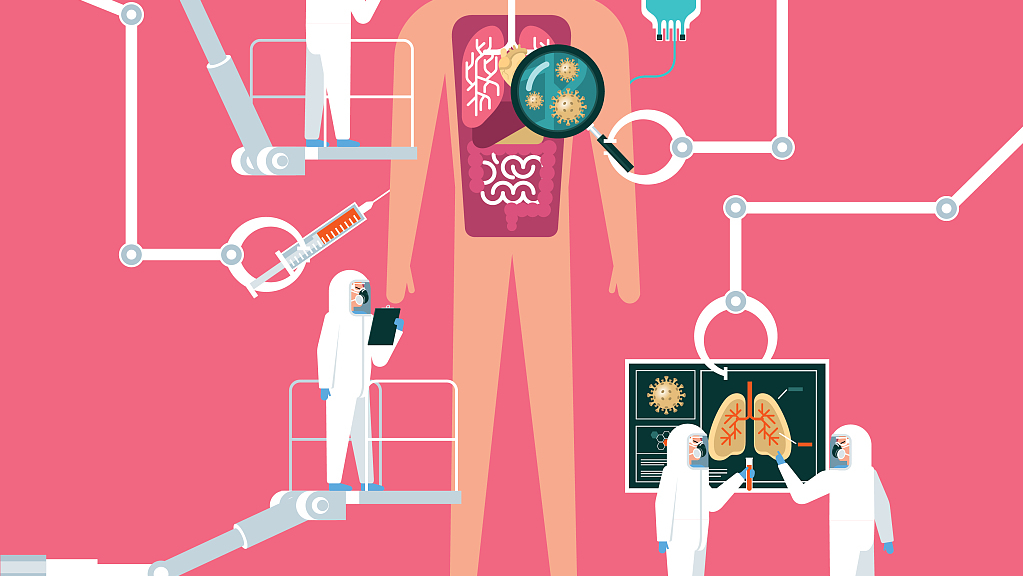
China's efforts in fighting the COVID-19 has achieved encouraging results as the Chinese mainland reported zero domestically transmitted cases on Wednesday for the first time since the outbreak. Even the World Health Organization lauded China's efforts, with a senior official saying that the country's experience in containing the spread of the virus can "serve as a lesson for other countries" now facing the pandemic.
Let's have a look at some cutting-edge technologies that China used in this battle.
Using BeiDou for building hospitals
China accomplished the great feat of building Huoshenshan and Leishenshan hospitals in central China's Wuhan City in less than a fortnight. Part of the "China speed" can be attributed to the country's BeiDou Navigation Satellite System (BDS), which provided highly precise positioning service and expedited construction.
The system also helped drones to spray disinfectant and patrol crowded places.
Information regarding epidemic prevention and transportation services was sent to over six million vehicles via the BDS terminals, ensuring the transportation of emergency materials to the most-hit areas.
Using AI, big data for containing the spread
In early February, China's Ministry of Industry and Information Technology called for leveraging artificial intelligence (AI) in the fight against the outbreak.
Fever is one of the main symptoms of COVID-19. By using AI-driven systems, transportation junctions, office buildings as well as communities can identify high body temperatures from a stream of moving people. Based on body shape and facial information, the system can assist staff to screen people with abnormal body temperature rapidly.
In accordance with relevant regulations and rules, cities in China are employing big data analysis platforms for finding close contacts of the COVID-19 patients or suspected cases. A cross-department data platform in Shanghai, combining information collected from police, health authorities and other government departments, can show the personnel inflow and movement, eventually alerting local community workers to take action if needed.
Personal QR health code is another way that local authorities have been using to contain the spread. In Hangzhou, one of the most digitized cities in China, one can apply for a pass online by filling in some necessary personal information like ID number, history of contact with patients and health condition. The computer-based system checks the info and allots different passes to the applicant.
Robots share medics' work
Intelligent robots have been developed with different functions to alleviate the pressure on medics.
Throat swab testing is one of the main methods of biological sample testing to confirm novel coronavirus infection. However, throat swabbing requires medical staff to have close contact with patients, which makes them vulnerable to cross infection. An intelligent robot that can collect throat swabs has been put into clinic trial to protect medical staff from viral infection and improve the accuracy of biological sample collection. Remotely controlled by medical staff, the robot is said to be able to collect throat swabs without hurting the subject's throat, and with a success rate of over 95 percent.
A hospital in Beijing is also shifting some of their work to a robot, who goes around the wards to deliver medications, take temperatures and tell patients about medical precautions. Medics say the robot, after just one week on the job, has provided "huge relief."
5G network facilitates online medical consultation
5G has been applied in tele-medicine sector in China for quite a long time. This time, it has also played a crucial role in the treatment of severe cases of novel coronavirus and sharing experiences nationwide and worldwide.
The two Wuhan hospitals are equipped with 5G network, via which patients can ask for immediate help and experts from other regions such as Beijing can discuss treatment plans with doctors working there.
"Huoshenshan Hospital is located at a relatively remote area, far from the city center. The primary 4G network could only cover a limited number of users. After we built the new network this time, it can not only cover the primary users but the construction workers working on the site, which exceed 3,000. It can meet their communication needs," said Li Shun, a project manager of Huawei 5G network in Hubei Province.
Also, 5G network has made remote CT scanning a reality.
"Through remote 5G transmissions, we are able to control the CT scanners in remote hospitals, from a far distance, on a real-time basis," Li Zhenlin, deputy director of the Radiology Department at West China Hospital of Sichuan University, told CGTN.
"We can standardize our checks and the quality of diagnoses across the board to prevent unnecessary repeated examinations. More importantly, we can optimize the image quality and doses of radiation released on the patient."